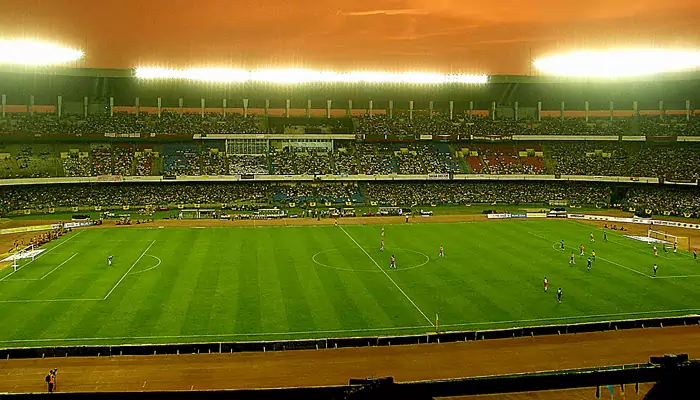
From Eden Gardens’ colonial-era origins to Narendra Modi Stadium’s futuristic scale, these arenas mirror India’s own 79-year journey
Imagine the roar of 100,000 voices echoing beneath the tricolour sky, the air thick with anticipation, and every cheer bearing the weight of a nation’s pride. India’s stadiums have been more than just brick and steel — they’ve been arenas where dreams take flight, where history is written in sweat and steel, and where the spirit of a free nation has been celebrated time and again.
In August, the month of our Independence, these arenas stand as silent witnesses to 79 years of sporting triumphs and unifying moments.
Built in 1864, Eden Gardens is more than just a stadium; it’s the heart of cricket in India. With a capacity of over 66,000, it has hosted everything from India’s early Test matches to the memorable 2001 victory over Australia.

Credit: ESPN
After independence, it became a stage where cricket shifted from a colonial pastime to a national passion. Whether it was Kapil Dev’s heroics or the packed stands during the 1987 World Cup, Eden Gardens reflects the increasing confidence of a young nation finding its sporting voice.
Continuing this legacy of grandeur, from the world’s oldest cricket ground, we move to the world’s largest—the Narendra Modi Stadium, with its astonishing 132,000 capacity—which embodies India's ambition in the 21st century.

Credit: Wikipedia
Reopened in 2020 in its new form, it has already hosted high-profile international matches, including the ODI World Cup 2023 final, IPL finals, and landmark events such as the "Namaste Trump" gathering. Its design, by Populous, combines advanced technology with fan comfort, symbolising a nation that now competes—and hosts—on the global stage without hesitation.
Shifting gears to Mumbai, Wankhede may be smaller in size (33,000 capacity), but it holds one of the most iconic memories in Indian sport: the 2011 Cricket World Cup final. As the final six sailed into the Mumbai night, it wasn’t just a victory — it was the culmination of decades of belief.

Credit: Crictracker
Since its opening in 1974, Wankhede has been the venue for IPL rivalries, Test match milestones, and countless emotional farewells, proving that greatness doesn’t always require massive walls.
Turning to New Delhi, Jawaharlal Nehru Stadium stands as a testament to multi-sport excellence. Built for the 1982 Asian Games and renovated for the 2010 Commonwealth Games, this 60,000-capacity stadium is India’s largest multi-sport arena.

Credit: Just Dial
It has hosted football, athletics, and cultural events that bring diverse crowds together. During the Commonwealth Games, it not only demonstrated India’s ability to win medals but also showcased its world-class infrastructure — a moment that enhanced India’s reputation as a sporting host.
Venturing further north, HPCA Stadium in Dharamshala shows that beauty can match strength. With just 23,000 seats, it opened in 2003 and offers players and fans a surreal view of the snow-capped Himalayas.

Credit: Wikipedia
Over the years, it has hosted IPL blockbusters and international clashes where the thin mountain air seemed charged with extra energy. It’s a reminder that Indian sport flourishes in every corner — from mega cities to mountain towns.
No survey of India’s iconic arenas would be complete without football’s own temple—the Vivekananda Yuba Bharati Krirangan. With a present capacity of 85,000, it is one of Asia’s largest and the pulsating centre of the East Bengal–Mohun Bagan rivalry.
![]()
Credit: Holidify
Its most renowned night came on 13 July 1997, during the Federation Cup semi-final, when an astonishing 1,34,000 fans packed the stands to watch East Bengal defeat Mohun Bagan 4–1, with Bhaichung Bhutia netting a hat-trick.
From hosting the SAFF Championships to the FIFA U-17 World Cup, the stadium has sustained India's football aspirations while demonstrating to the world that our sporting culture is far richer than cricket alone.